Plastic Crushing Failure of Bio-Inspired Cellular Hierarchical Topological Sandwich Core
Abstract
:1. Introduction
2. Experimental Details
2.1. Hierarchical Honeycomb Topologies
2.2. Selective Laser Melting (SLM) Fabricating Method
2.3. Mechanical Testing
2.3.1. Uniaxial Tensile Test of Constituent Materials
2.3.2. In-Plane Compression Test of Hierarchical Honeycomb Specimens
3. Results and Discussion
3.1. Uniaxial Tensile Characteristics of SLM Manufactured AlSi10Mg Alloy and 316L Steel Material
3.2. In-Plane Compressive Behavior of Hierarchical Honeycombs
3.2.1. Compressive Stress versus Strain Relations
3.2.2. Deformation Modes of AlSi10Mg Alloy Hierarchical Honeycombs
3.2.3. Deformation Modes of 316L Steel Hierarchical Honeycombs
3.3. In-Plane Failure Mechanism of Hierarchical Honeycombs
3.4. Comparison of Mechanical Properties between AlSi10Mg Alloy and 316L Steel Hierarchical Honeycombs
3.4.1. Compressive Strength
3.4.2. Elastic Modulus
4. Conclusions
Author Contributions
Funding
Institutional Review Board Statement
Informed Consent Statement
Acknowledgments
Conflicts of Interest
References
- Zhang, Y.; Liu, T.; Tizani, W. Experimental and numerical analysis of dynamic compressive response of Nomex honeycombs. Compos. Part B Eng. 2018, 148, 27–39. [Google Scholar] [CrossRef]
- Li, X.; Lin, Y.; Lu, F.; Zhang, Y. Quasi-static cutting response of combined hexagonal aluminium honeycombs at various stacking angles. Compos. Struct. 2020, 238, 111942. [Google Scholar] [CrossRef]
- Kim, B.; Christensen, R.M. Basic two-dimensional core types for sandwich structures. Int. J. Mech. Sci. 2000, 42, 657–676. [Google Scholar] [CrossRef]
- Liu, J.; Chen, W.; Hao, H.; Wang, Z. In-plane crushing behaviors of hexagonal honeycombs with different Poisson’s ratio induced by topological diversity. Thin-Walled Struct. 2021, 159, 107223. [Google Scholar] [CrossRef]
- Zhang, Y.; Wang, S.; Yan, L. Transverse compressive characteristics of fiber reinforced cementitious composites tubes. Thin-Walled Struct. 2020, 150, 106645. [Google Scholar] [CrossRef]
- Wadley, H.N.G. Multifunctional periodic cellular metals. Philos. Trans. R. Soc. A Math. Phys. Eng. Sci. 2005, 364, 31–68. [Google Scholar] [CrossRef] [PubMed]
- Wang, A.-J.; McDowell, D.L. In-Plane Stiffness and Yield Strength of Periodic Metal Honeycombs. J. Eng. Mater. Technol. 2004, 126, 137–156. [Google Scholar] [CrossRef]
- Yang, C.; Shahverdi, M.H.; Keshavanarayana, S.R.; Horner, A.L. An analytical approach to characterize uniaxial in-plane responses of commercial hexagonal honeycomb core under large deformations. Compos. Struct. 2019, 211, 100–111. [Google Scholar] [CrossRef]
- Zhu, F.; Zhao, L.; Lu, G.; Gad, E. A numerical simulation of the blast impact of square metallic sandwich panels. Int. J. Impact Eng. 2009, 36, 687–699. [Google Scholar] [CrossRef]
- Dharmasena, K.; Queheillalt, D.; Wadley, H.; Dudt, P.; Chen, Y.; Knight, D.; Evans, A.; Deshpande, V. Dynamic compression of metallic sandwich structures during planar impulsive loading in water. Eur. J. Mech. A/Solids 2010, 29, 56–67. [Google Scholar] [CrossRef]
- Côté, F.; Deshpande, V.; Fleck, N.; Evans, A. The compressive and shear responses of corrugated and diamond lattice materials. Int. J. Solids Struct. 2006, 43, 6220–6242. [Google Scholar] [CrossRef] [Green Version]
- Yin, H.; Huang, X.; Scarpa, F.; Wen, G.; Chen, Y.; Zhang, C. In-plane crashworthiness of bio-inspired hierarchical honeycombs. Compos. Struct. 2018, 192, 516–527. [Google Scholar] [CrossRef] [Green Version]
- Fleck, N.A.; Deshpande, V.S.; Ashby, M.F. Micro-architectured materials: Past, present and future. Proc. R. Soc. A Math. Phys. Eng. Sci. 2010, 466, 2495–2516. [Google Scholar] [CrossRef]
- Fan, H.; Jin, F.; Fang, D. Mechanical properties of hierarchical cellular materials. Part I: Analysis. Compos. Sci. Technol. 2008, 68, 3380–3387. [Google Scholar] [CrossRef]
- Liu, Z.; Meyers, M.A.; Zhang, Z.; Ritchie, R.O. Functional gradients and heterogeneities in biological materials: Design principles, functions, and bioinspired applications. Prog. Mater. Sci. 2017, 88, 467–498. [Google Scholar] [CrossRef]
- Zhang, Y.; Liu, T.; Ren, H.; Maskery, I.; Ashcroft, I. Dynamic compressive response of additively manufactured AlSi10Mg alloy hierarchical honeycomb structures. Compos. Struct. 2018, 195, 45–59. [Google Scholar] [CrossRef]
- Lakes, R.S. Materials with structural hierarchy. Nature 1993, 361, 511–515. [Google Scholar] [CrossRef]
- Oftadeh, R.; Haghpanah, B.; Vella, D.; Boudaoud, A.; Vaziri, A. Optimal Fractal-Like Hierarchical Honeycombs. Phys. Rev. Lett. 2014, 113, 104301. [Google Scholar] [CrossRef] [PubMed] [Green Version]
- Haghpanah, B.; Oftadeh, R.; Papadopoulos, J.; Vaziri, A. Self-similar hierarchical honeycombs. Proc. R. Soc. A Math. Phys. Eng. Sci. 2013, 469, 1–19. [Google Scholar] [CrossRef] [Green Version]
- Li, Z.; Shen, L.; Wei, K.; Wang, Z. Compressive behaviors of fractal-like honeycombs with different array configurations under low velocity impact loading. Thin-Walled Struct. 2021, 163, 107759. [Google Scholar] [CrossRef]
- Chen, Y.; Li, T.; Jia, Z.; Scarpa, F.; Yao, C.-W.; Wang, L. 3D printed hierarchical honeycombs with shape integrity under large compressive deformations. Mater. Des. 2018, 137, 226–234. [Google Scholar] [CrossRef] [Green Version]
- Zhang, K.; Deng, Z.; Xu, X.; Hou, X.; Meng, J. Symplectic analysis for wave propagation of hierarchical honeycomb structures. Acta Mech. Solida Sin. 2015, 28, 294–304. [Google Scholar] [CrossRef]
- Mousanezhad, D.; Babaee, S.; Ghosh, R.; Mahdi, E.; Bertoldi, K.; Vaziri, A. Honeycomb phononic crystals with self-similar hierarchy. Phys. Rev. B 2015, 92. [Google Scholar] [CrossRef] [Green Version]
- Oftadeh, R.; Haghpanah, B.; Papadopoulos, J.; Hamouda, A.M.; Nayeb-Hashemi, H.; Vaziri, A. Mechanics of anisotropic hierarchical honeycombs. Int. J. Mech. Sci. 2014, 81, 126–136. [Google Scholar] [CrossRef]
- Maskery, I.; Aboulkhair, N.T.; Corfield, M.; Tuck, C.; Clare, A.; Leach, R.; Wildman, R.; Ashcroft, I.; Hague, R. Quantification and characterisation of porosity in selectively laser melted Al–Si10–Mg using X-ray computed tomography. Mater. Charact. 2015, 111, 193–204. [Google Scholar] [CrossRef] [Green Version]
- Imbalzano, G.; Linforth, S.; Ngo, T.; Lee, P.V.S.; Tran, P. Blast resistance of auxetic and honeycomb sandwich panels: Comparisons and parametric designs. Compos. Struct. 2018, 183, 242–261. [Google Scholar] [CrossRef]
- Gibson, L.J.; Ashby, M.F. Cellular Solids: Structure and Properties; Cambridge University Press: Cambridge, UK, 1997. [Google Scholar]
- Malek, S.; Gibson, L. Effective elastic properties of periodic hexagonal honeycombs. Mech. Mater. 2015, 91, 226–240. [Google Scholar] [CrossRef]
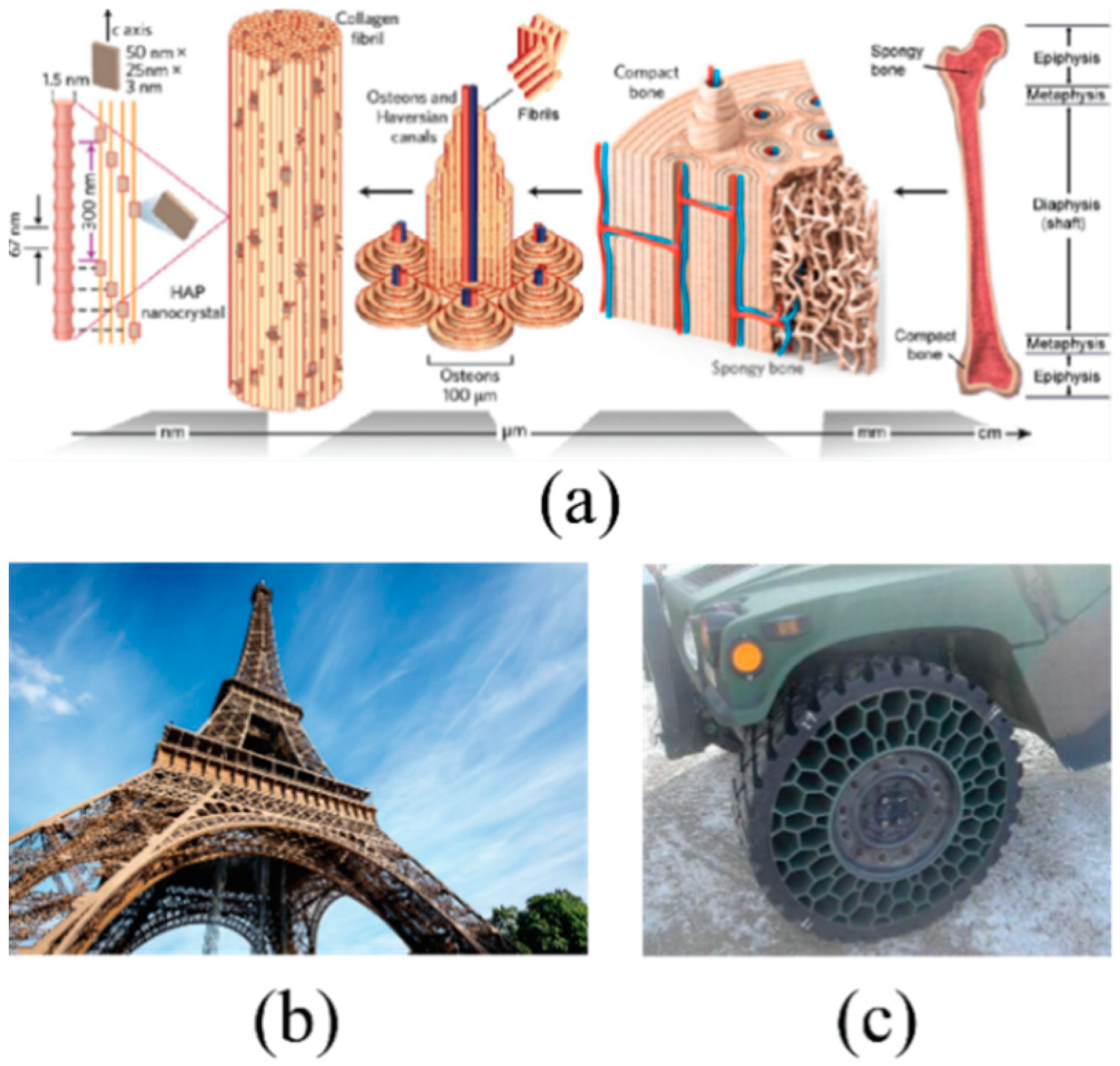

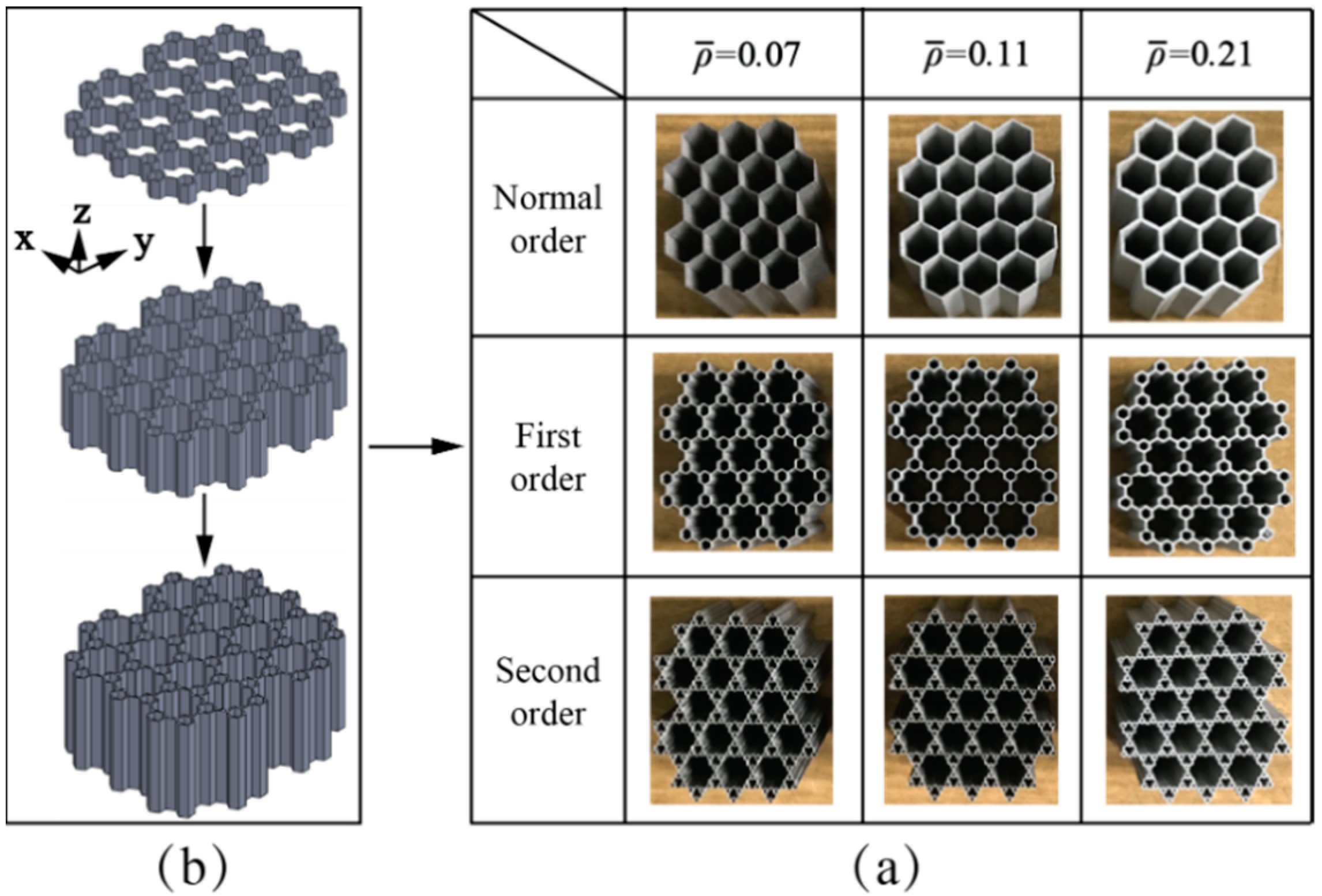
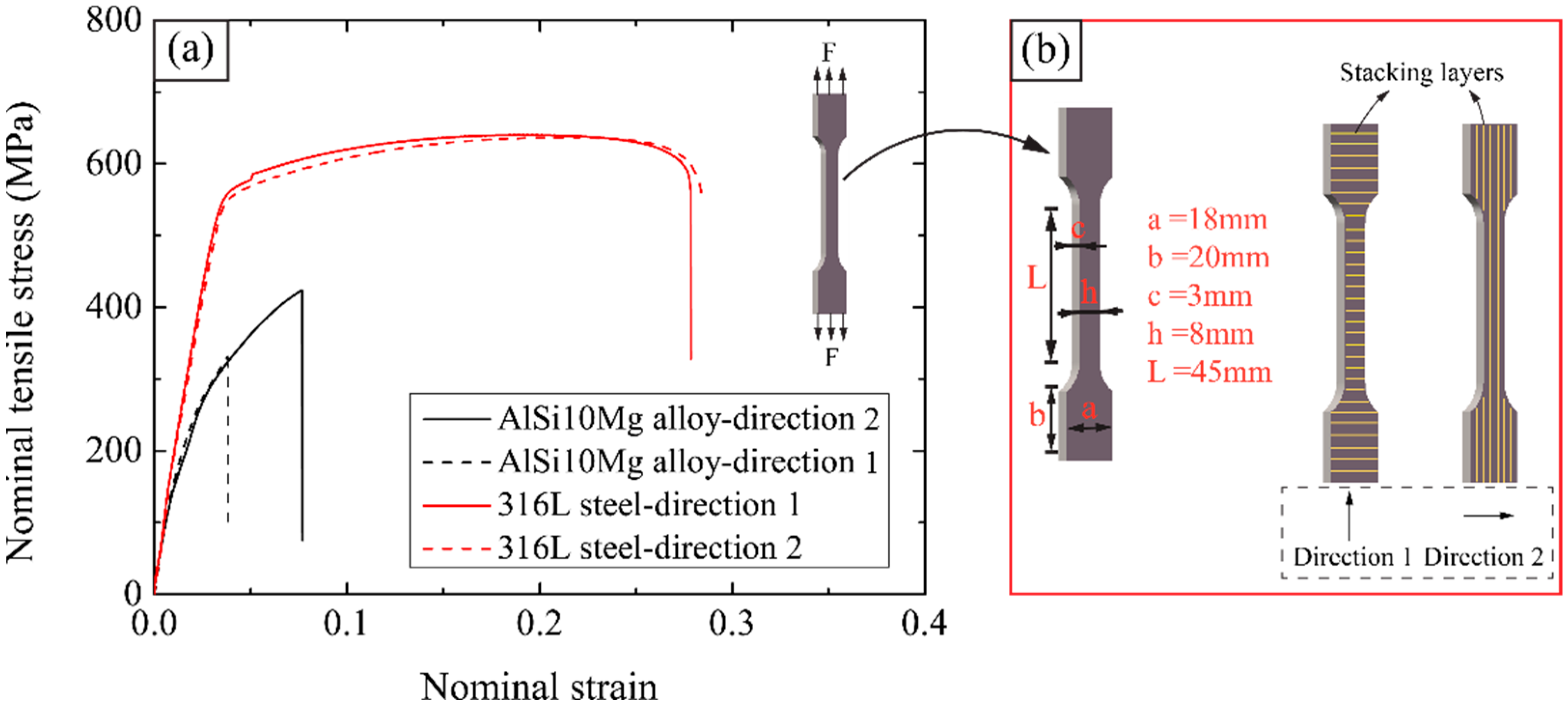



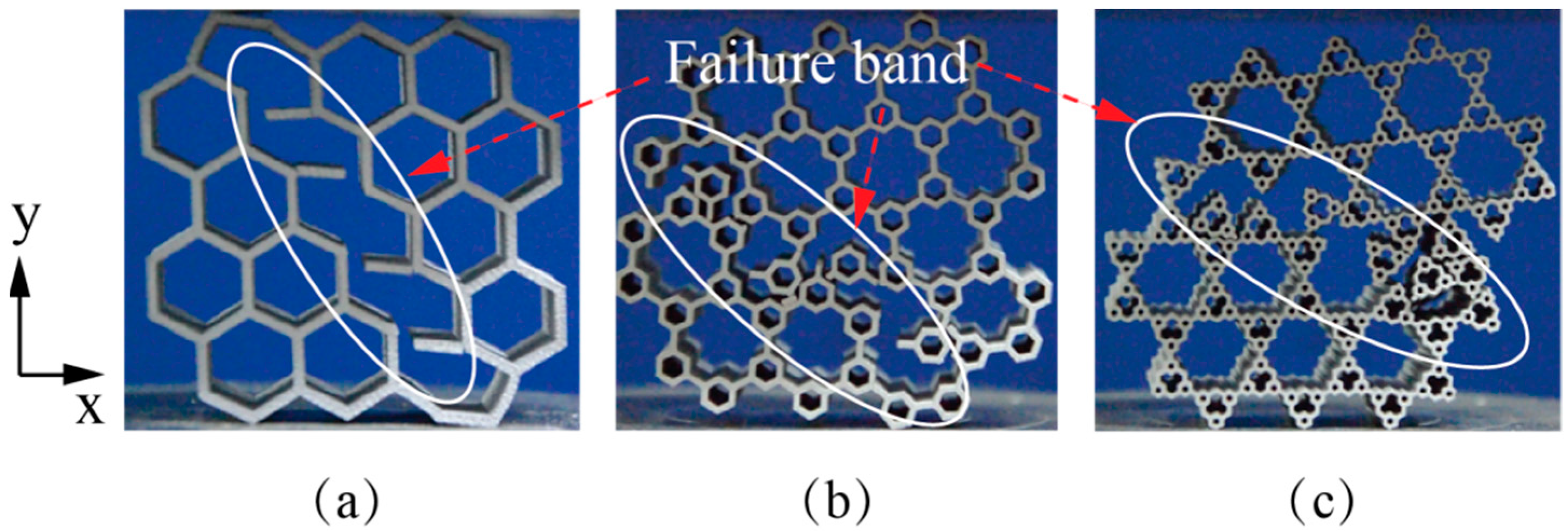
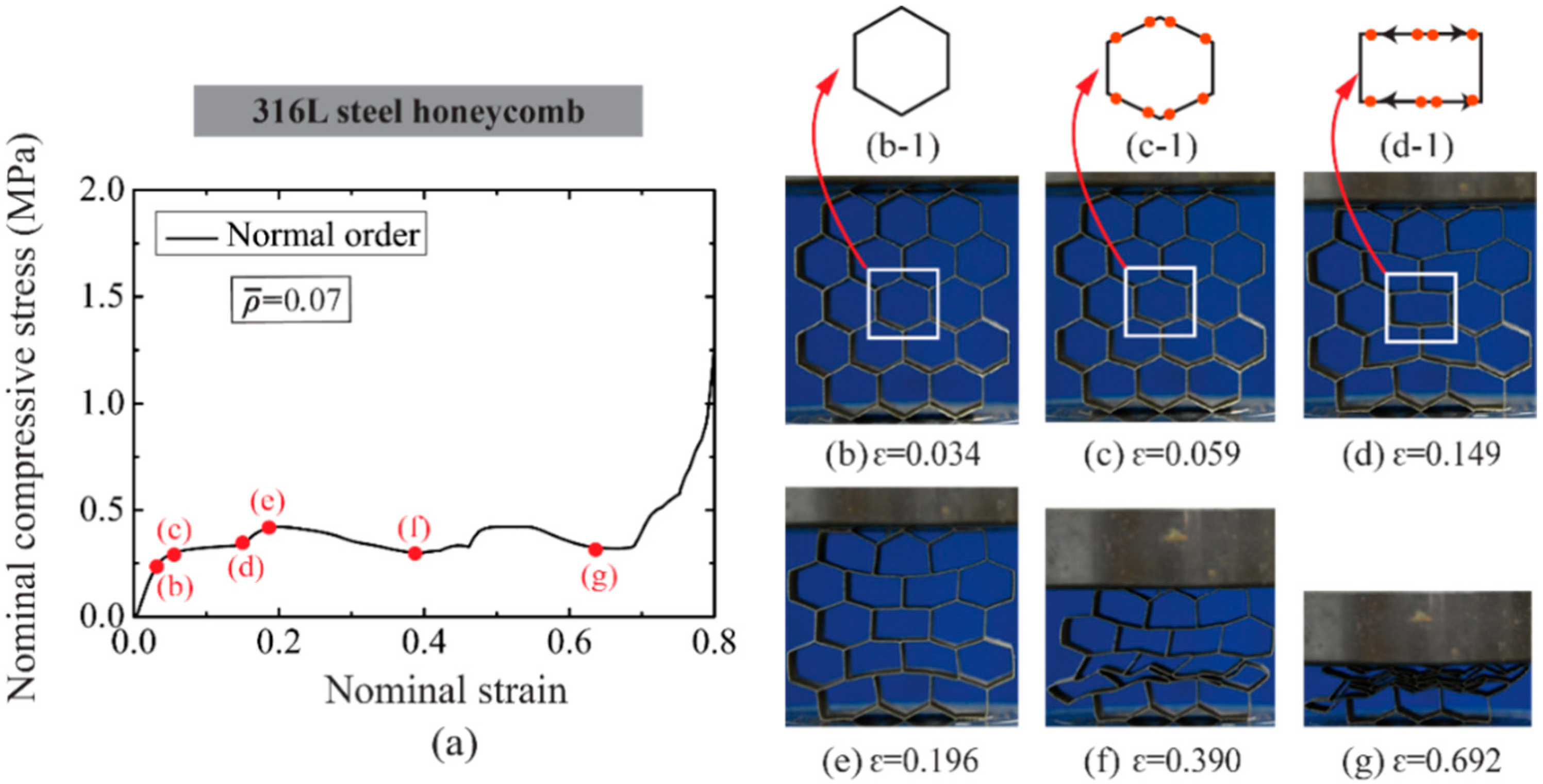

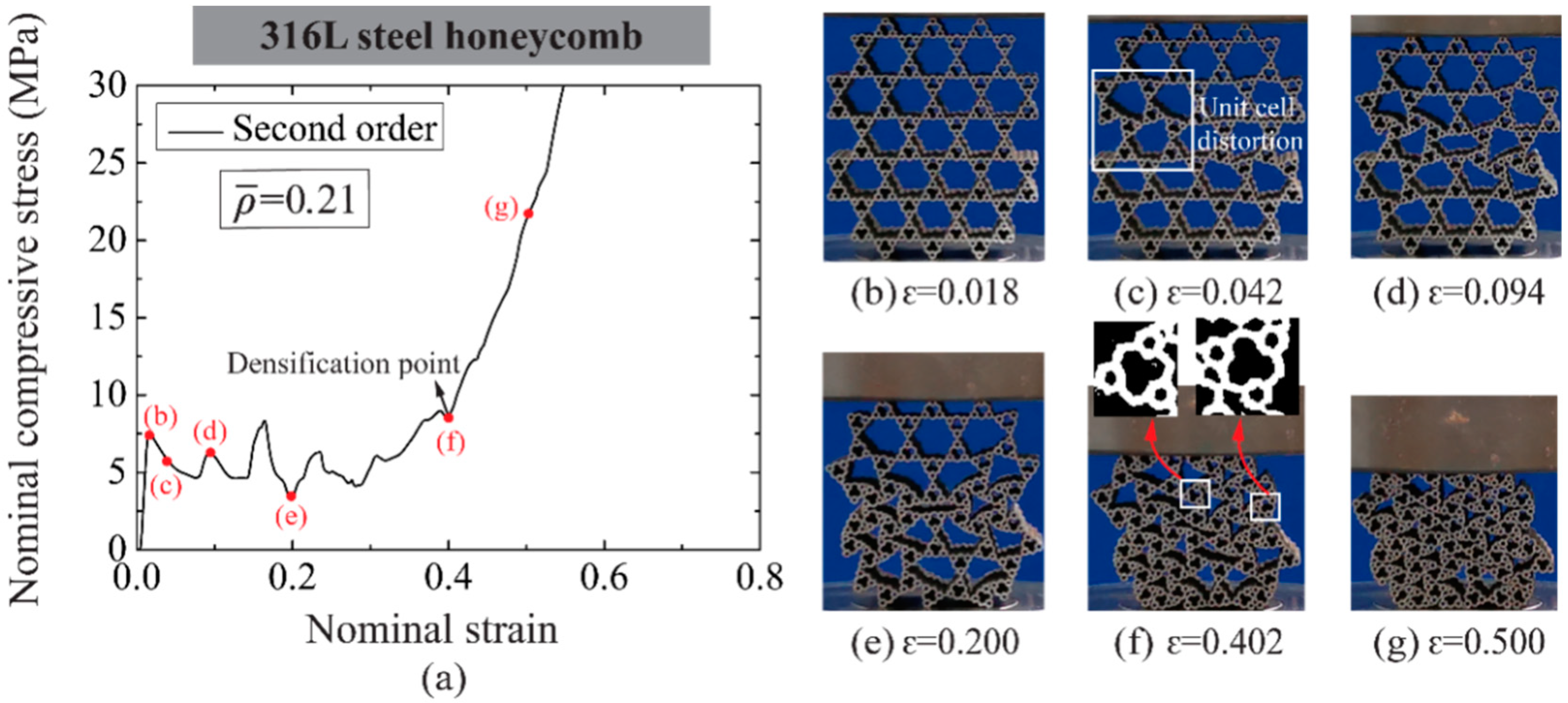

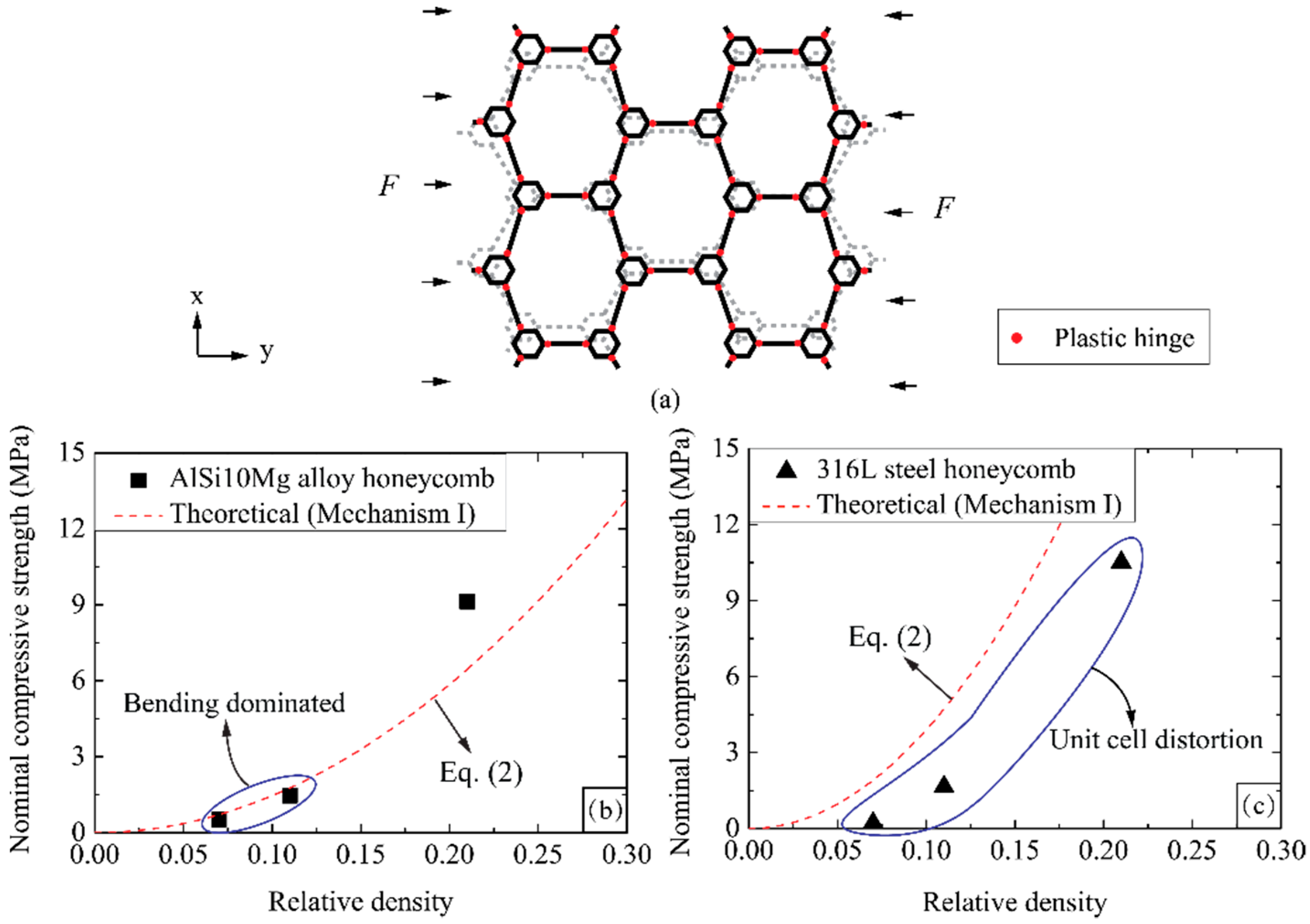
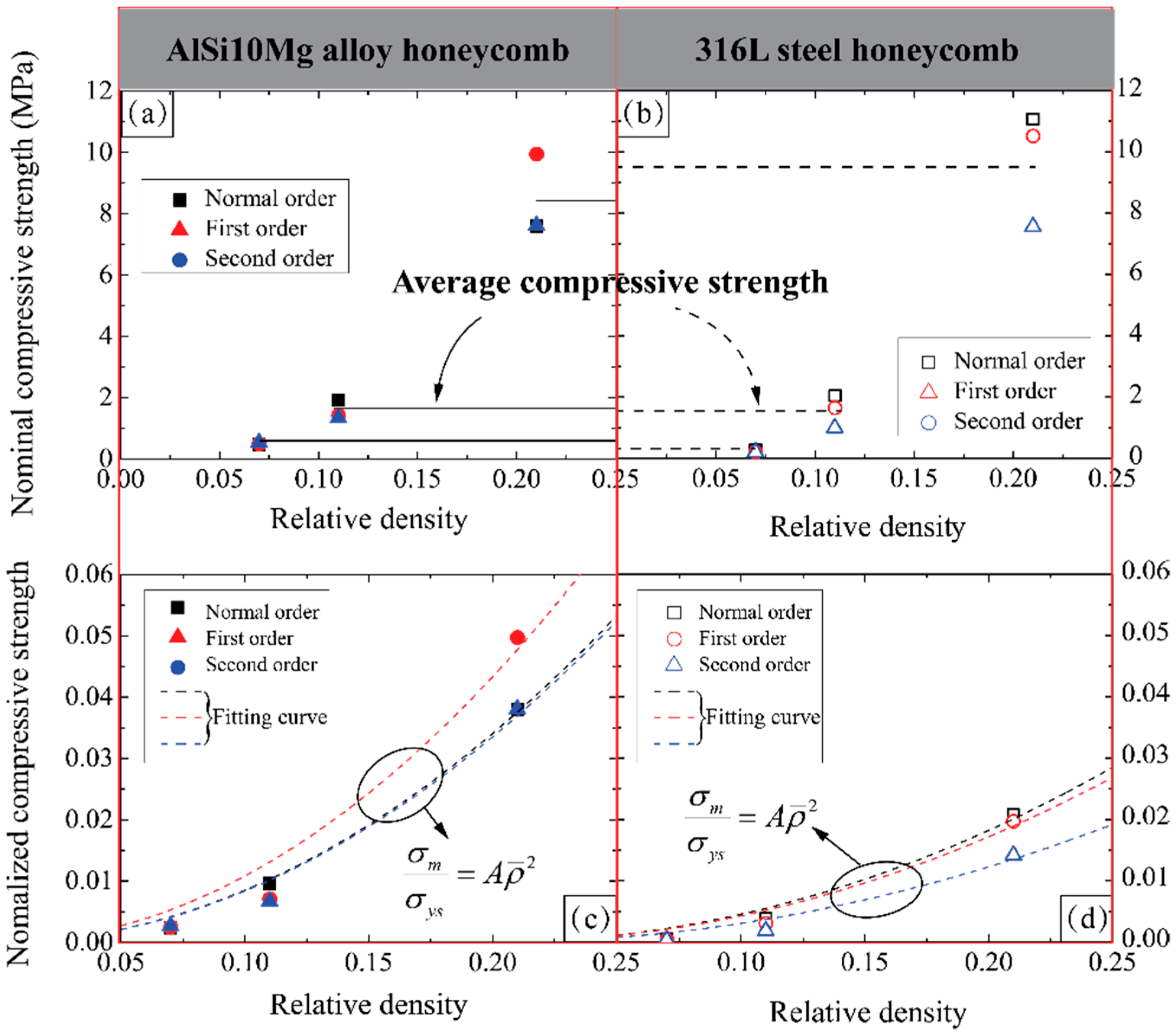
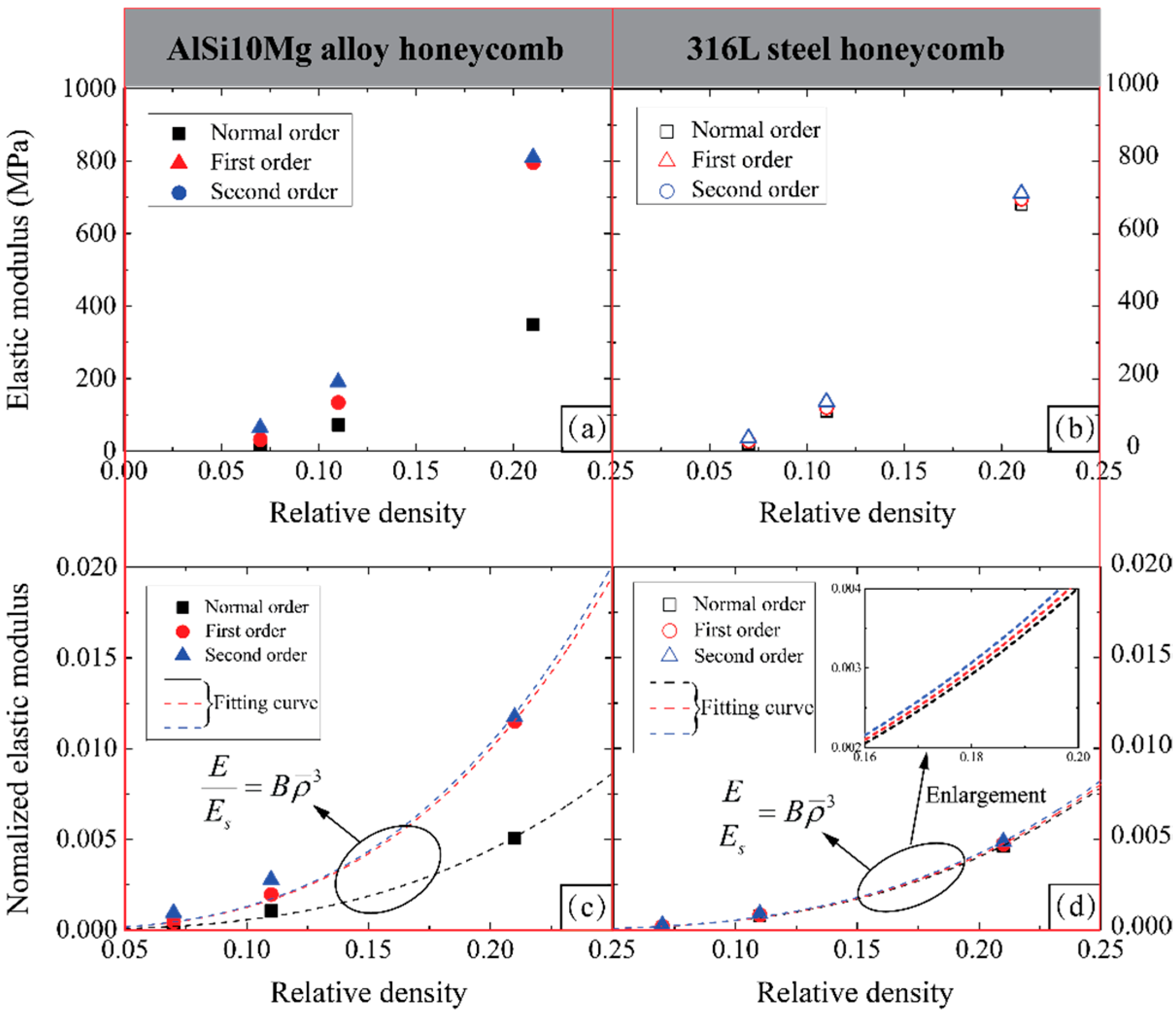
| Materials | Numbering | |||||
|---|---|---|---|---|---|---|
| AlSi10Mg alloy/ 316L steel | AL-N7/ST-N7 | 0.40 | 6.7 | - | - | 0.069 |
| AL-F7/ST-F7 | 0.26 | 0.3 | - | 0.072 | ||
| AL-S7/ST-S7 | 0.2 | 0.3 | 0.12 | 0.080 | ||
| AL-N11/ST-N11 | 0.64 | - | - | 0.110 | ||
| AL-F11/ST-F11 | 0.42 | 0.3 | - | 0.116 | ||
| AL-S11/ST-S11 | 0.29 | 0.3 | 0.12 | 0.116 | ||
| AL-N21/ST-N21 | 1.28 | - | - | 0.220 | ||
| AL-F21/ST-F21 | 0.74 | 0.3 | - | 0.204 | ||
| AL-S21/ST-S21 | 0.54 | 0.3 | 0.12 | 0.216 |
| Mechanical Properties | AlSi10Mg Alloy | 316L Steel | ||||||
|---|---|---|---|---|---|---|---|---|
| Direction 1 | Standard Deviation | Direction 2 | Standard Deviation | Direction 1 | Standard Deviation | Direction 2 | Standard Deviation | |
| Elastic modulus Es | 71 GPa | 3.5 GPa | 53 GPa | 3.2 GPa | 147 GPa | 9.7 GPa | 147 GPa | 10.3 GPa |
| Yield strength σys | 200 MPa | 5.8 MPa | 200 MPa | 13.4 MPa | 533 MPa | 21.4 MPa | 524 MPa | 24.3 MPa |
| Tensile strength σt | 423 MPa | 11.2 MPa | 331 MPa | 20.9 MPa | 640 MPa | 29.7 MPa | 639 MPa | 37.8 MPa |
| Failure strain εt | 7.7% | 0.67% | 3.8% | 0.29% | 27.8% | 1.81% | 28.3% | 1.94% |
| Honeycomb Type | AlSi10Mg Alloy Honeycomb | 316L Steel Honeycomb | |||
|---|---|---|---|---|---|
| E (MPa) | E (MPa) | ||||
| 0.07 | Normal order | 0.47 | 17.75 | 0.28 | 20.09 |
| First-order | 0.50 | 31.89 | 0.21 | 28.32 | |
| Second-order | 0.54 | 64.36 | 0.20 | 36.48 | |
| 0.11 | Normal order | 1.92 | 72.37 | 2.05 | 110.45 |
| First-order | 1.42 | 134.41 | 1.65 | 120.15 | |
| Second-order | 1.34 | 190.65 | 1.00 | 126.69 | |
| 0.21 | Normal order | 7.59 | 349.49 | 11.06 | 680.80 |
| First-order | 9.94 | 794.74 | 10.51 | 694.72 | |
| Second-order | 7.61 | 810.26 | 7.56 | 711.28 | |
| Honeycomb Order | AlSi10Mg Alloy | 316L Steel |
|---|---|---|
| Normal | 0.8516 | 0.4558 |
| First | 1.0826 | 0.4298 |
| Second | 0.8379 | 0.3072 |
Publisher’s Note: MDPI stays neutral with regard to jurisdictional claims in published maps and institutional affiliations. |
© 2021 by the authors. Licensee MDPI, Basel, Switzerland. This article is an open access article distributed under the terms and conditions of the Creative Commons Attribution (CC BY) license (https://creativecommons.org/licenses/by/4.0/).
Share and Cite
Zhang, Y.; Lin, Y.; Li, X. Plastic Crushing Failure of Bio-Inspired Cellular Hierarchical Topological Sandwich Core. Materials 2021, 14, 5040. https://doi.org/10.3390/ma14175040
Zhang Y, Lin Y, Li X. Plastic Crushing Failure of Bio-Inspired Cellular Hierarchical Topological Sandwich Core. Materials. 2021; 14(17):5040. https://doi.org/10.3390/ma14175040
Chicago/Turabian StyleZhang, Yuwu, Yuliang Lin, and Xiangcheng Li. 2021. "Plastic Crushing Failure of Bio-Inspired Cellular Hierarchical Topological Sandwich Core" Materials 14, no. 17: 5040. https://doi.org/10.3390/ma14175040






